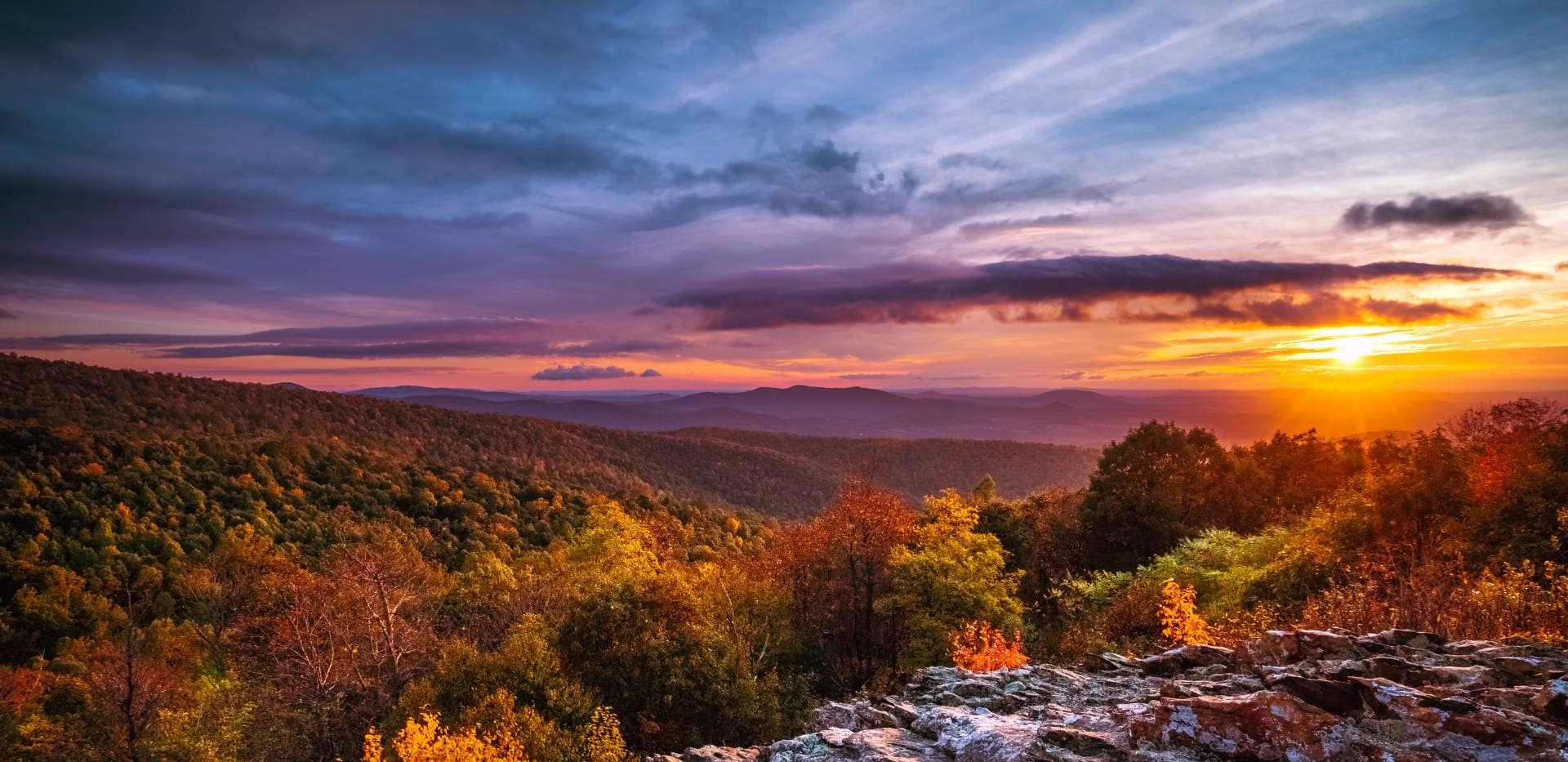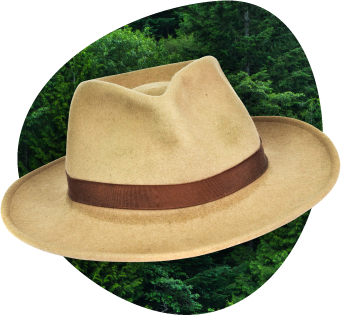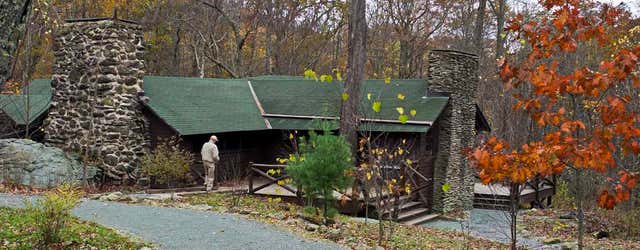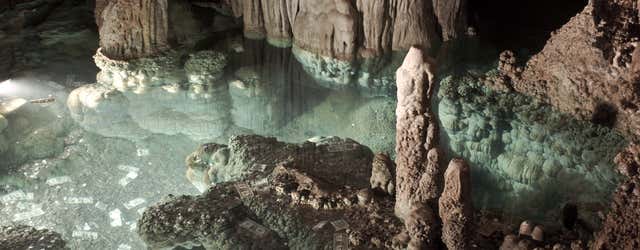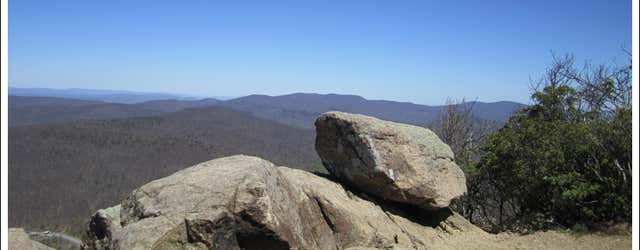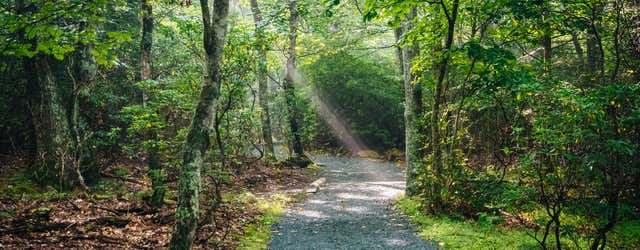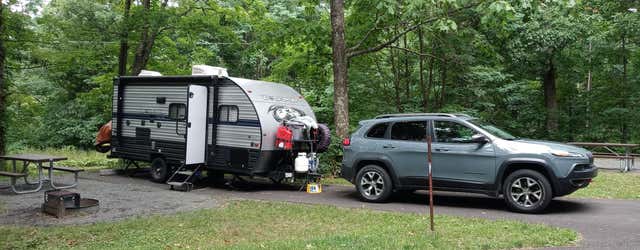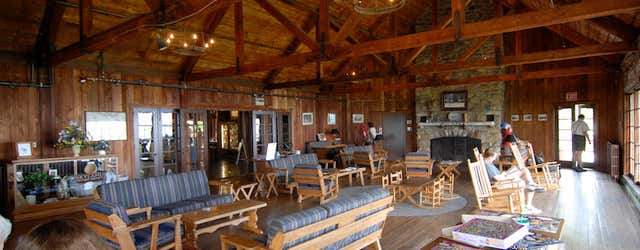In the early 1920s, the National Park Service’s first director, Stephen Mather, recognized that his agency had a problem. The NPS was good at promoting parks in the American West, but—with their wonders thousands of miles from where most Americans lived—these parks were out of reach for all but the richest or most dedicated tourists. Mather knew that he needed to bring national parks to the people. At the time, that meant bringing them to the East. The result? Shenandoah National Park.
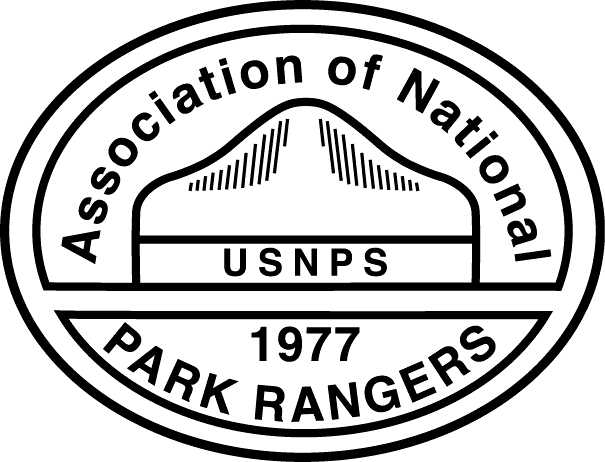
Written for you by park rangers
Who knows a national park best? Yep, the rangers who live and breathe its fresh, clean air every day. That’s who we turned to for help in creating this guide. Roadtrippers has partnered with the Association of National Park Rangers and convinced its rangers to spill their secrets for your benefit.
Getting to Shenandoah National Park
Located in the Blue Ridge Mountains of northern Virginia, Shenandoah is near several airports:
- Washington Dulles International Airport (IAD): 56 miles east of Front Royal
- Reagan National Airport (DCA): 70 miles east of Front Royal
- Shenandoah Valley Regional Airport (SHD): 27 miles west of Swift Run Gap
- Charlottesville Albemarle Airport (CHO): 31 miles east of Rockfish Gap
Long and narrow, the park is defined by a single public road, Skyline Drive, which runs its entire length from north to south. The road is numbered from Mile 0 in the north near Front Royal to Mile 105 in the south near Waynesboro. It’s broken into three distinct sections—North, Central, and South—by highways that cross east to west.
If you are driving an RV, camping trailer, or horse trailer, be sure that you can clear Marys Rock Tunnel (just south of the Thornton Gap entrance from Route 211) with a height of 12 feet, 8 inches. Otherwise, you’ll need to exit and make a sizable detour.
Timing your visit to Shenandoah National Park
There are benefits to visiting Shenandoah at all times of year, depending on your interests.
Shoulder seasons
In terms of crowds and getting reservations, the easiest time of the year to visit is late April to late May. With relatively few leaves on the trees, it’s easy to get sweeping vistas, see the remains of former settlers’ homesteads, and avoid ticks. Expect cold nights and pleasant days. Of course, in the fall, you may choose to be one of the leaf peepers who descend on the park.
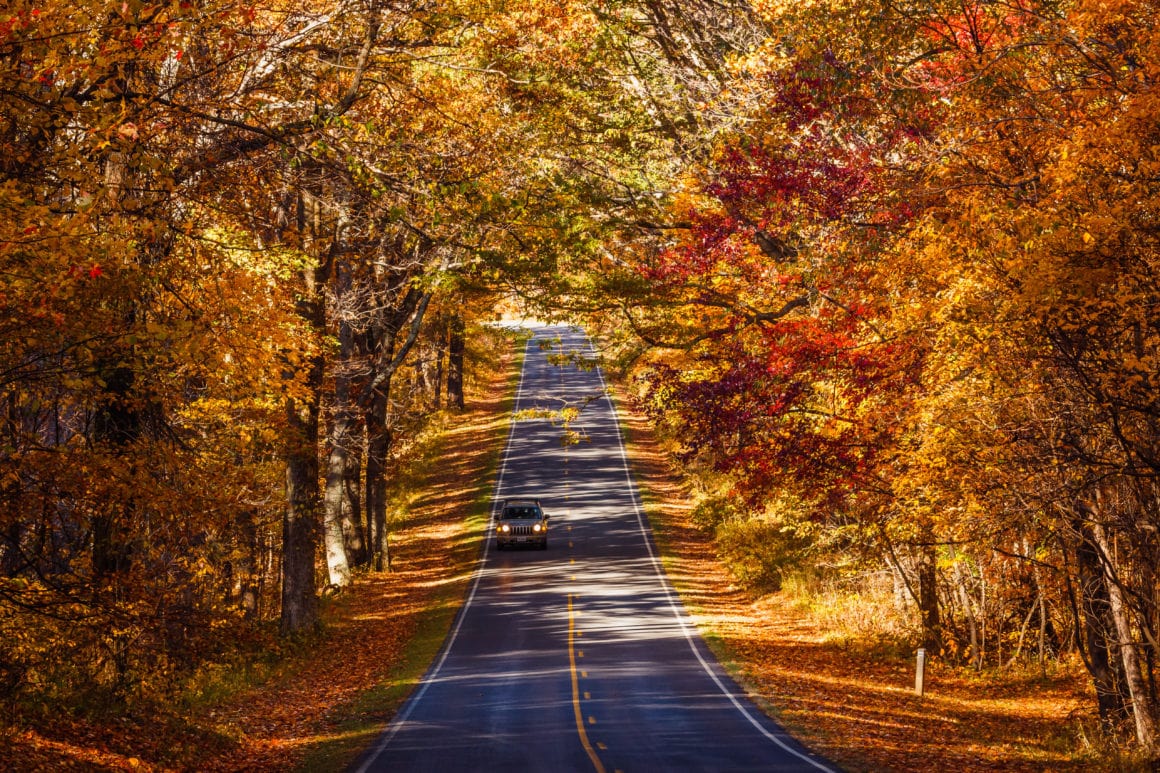
Summer
As with most national parks, summer is peak season at Shenandoah. It’s best to make advance reservations for all lodging and camping.
Winter
Winter can be an opportunity to experience the park’s beauty in near solitude. Facilities including visitor centers, lodges, and restaurants are shut down, so come prepared. Skyline Drive can close in inclement weather. Call ahead for road conditions: (540) 999-3500.
During the winter, fuel is only available via a self-pay system at Big Meadows, so it’s best to arrive at the park with a full tank of gas.
Things to do in Shenandoah National Park
Visitors who travel to Shenandoah won’t have a shortage of activities. The park’s most popular destinations include waterfalls, overlooks, and historic sites.
Visitor centers
Located near Big Meadows Lodge and Campground in the center of the park, Byrd Visitor Center (Mile 51) is the main visitor center. Here, you’ll see exhibits about the park’s flora, fauna, and human history including the controversial displacement of more than 500 families in the creation of the park. You’ll also learn about all of the work that park rangers did to make Shenandoah more like national parks across the West.
Make sure to check the ranger program schedule; at a minimum, it’s a good idea to listen to the bear safety talk. Yes, there are plenty of black bears in Shenandoah! This visitor center is also the departure point for van tours to President Herbert Hoover’s Rapidan Camp. The visitor center is typically open from 9 a.m. to 5 p.m.; in the winter (late November to early April), it’s closed during the week but open on weekends until late December, weather permitting, from 9:30 a.m. to 4 p.m. Call ahead for road conditions: (540) 999-3500.
The Dickey Ridge Visitor Center (Mile 4.6) is located near the northern Front Royal entrance. Like at Byrd, you can watch the park movie, chat with rangers, see exhibits, and shop at the bookstore. Closed during the winter (late November to early April), it’s open from 8:30 a.m. to 5 p.m. during other parts of the year (except Wednesdays or Thursdays).

Skyline Drive
Think of Skyline Drive as a hopelessly-curved spine, sitting atop a mountain ridge. Nearly all the hiking trails either descend or ascend from this road. But the drive itself is meant to be experienced, which is why it has a strict speed limit of 35 mph. It offers stunning views of the Blue Ridge Mountains and possible sightings of wildlife including deer, wild turkeys, and black bears, especially in the morning or at dusk.
Luray Caverns
While technically not a part of the national park, Luray Caverns is just a short drive away on U.S. Highway 340. Open year-round with a constant temperature of 54°F, take a one-hour tour of this subterranean world along well-lit and well-paved paths.
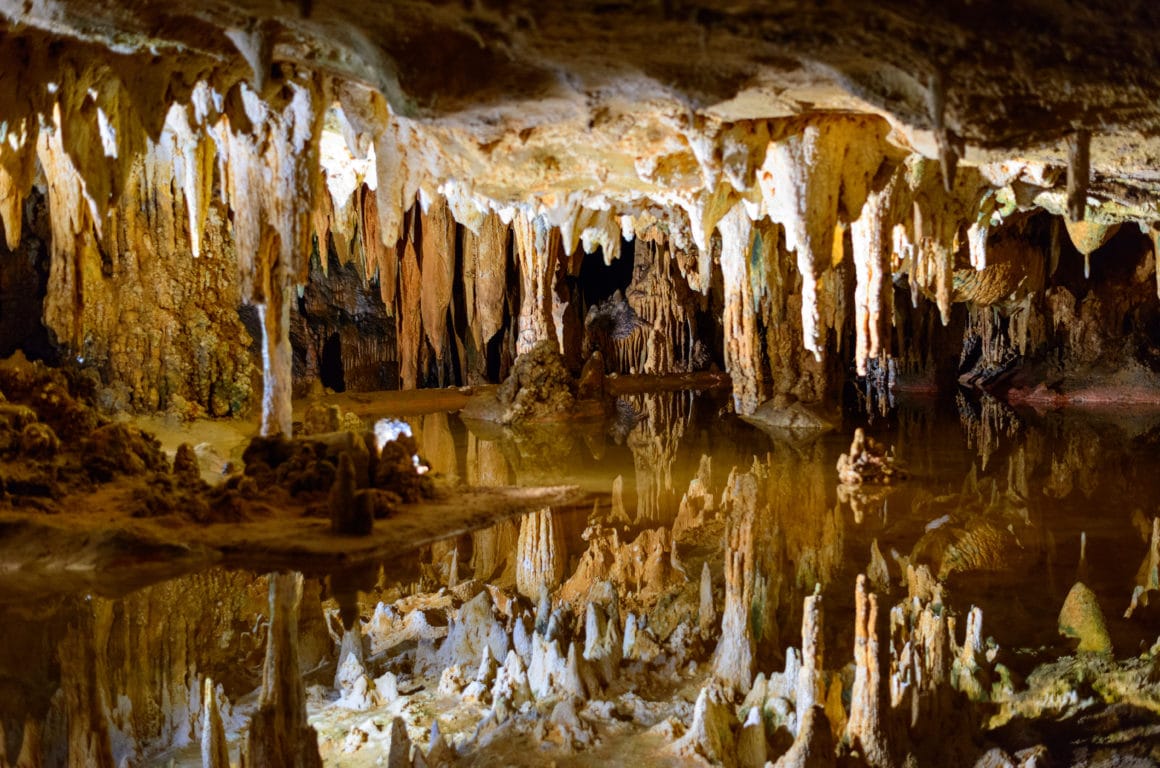
Historic site
If you’d like to learn about one of the park’s most famous visitors, make time for a walk down to President Herbert Hoover’s Rapidan Camp. Originally constructed as a presidential retreat, Hoover deeded the property to the federal government after his term in office ended. The site would have faded into oblivion if it wasn’t for the concerted effort by the National Park Service to rehabilitate it as a destination to learn about Hoover’s involvement in the creation of Shenandoah. You can hike the 4-mile (round trip) Mill Prong Trail to the site, but there’s no guarantee that you can tour the buildings; it will depend on volunteer staffing. Alternatively, you can book a 2.5-hour, ranger-led tour which includes guaranteed access and a 30-minute van ride (instead of the hike) on Thursdays through Sundays from late May to late October. Tours can be booked six months in advance.
Waterfalls
Several of the hikes that descend from Skyline Drive lead to a refreshing waterfall. The most popular hike in the park, Dark Hollow Falls (Mile 50.7) is a 1.4-mile (round trip) trail with an elevation change of 564 feet. If you want to see some equally-scenic, but less-visited waterfalls, hike the 2.6-mile (round trip) trail to the overlook right next to Rose River Falls (Mile 49.4) in the Big Meadows Area. The walk down is easy, but the walk back to the trailhead is steep.
Biking
Biking is allowed along Skyline Drive, but cyclists need to be cautious of the steep hills and blind curves. The road has a fair amount of traffic during the summer. Bikes are not allowed on trails or unpaved roads.
Horseback riding
You also can explore Shenandoah on horseback. Tours are offered at Skyland Stables (Mile 42.5) from mid-April to mid-November. Riders must be at least 4 feet, 10 inches tall and weigh less than 250 pounds. For little ones (age 5 and under), wrangler-led pony rides are available. If you own a horse, read the park regulations for trail riding.
Hiking in Shenandoah National Park
With more than 500 miles of trails, hiking is really the main activity in Shenandoah. Hikes are rated from easy to very strenuous; know that even the easy hikes involve a hike downhill and then, of course, a hike uphill. In addition to the waterfall trails already mentioned, here are some recommendations, moving from north to south in the park.
Using a GPS-enabled device, you can discover special natural features as part of the park’s earthcaching program. As opposed to geocaching, there are no physical items to find, just nature wonders to treasure.
Marys Rock (Mile 31.6 and 33.5)
A popular hike in the park, Marys Rock is a moderately difficult trail that ascends through the forest and ends at a rocky viewpoint overlooking the valley. You can assess the 3.7-mile (round trip) trail from Panorama (Mile 31.6) or the 2.9-mile (round trip) trail from Meadow Spring (Mile 33.5).
Limberlost (Mile 43)
If you have more time and want to get farther afield, don’t miss the easy 1.3-mile (round trip) Limberlost Trail. This flat, fully accessible trail shows the long-term effects of invasive species on Shenandoah’s hemlock forests. This formerly Hemlock-rich area was stripped by the destructive hemlock wooly adelgid. On the trail, you’ll learn about forest succession and the National Park Service’s work to protect this iconic eastern species of tree.
Bearfence (Mile 56.4)
This short (1.2 miles round trip) but strenuous hike and rock scramble rewards visitors with a 360° view across the park. In this ranger’s opinion, it’s the park hike with the best return per number of hours invested.
Keep a close eye on kids when hiking this trail.
Staying in and around Shenandoah
Shenandoah offers a variety of options for campers and non-campers alike.
Lodges and Cabins
Big Meadows Lodge (Mile 51) offers the rustic charm that you’d expect from a national park lodge. It has 25 rooms in the main lodge plus 71 additional rooms in detached cabins, multi-unit lodges, and suites; some rooms are pet-friendly. Be sure to reserve in advance. The lodge is closed during the winter.
Even if you don’t stay at the lodge, be sure to stop and check on the inviting great room.
At Skyline Drive’s highest elevation, you’ll find Skyland (Mile 41.7), offering 179 guest rooms, rustic cabins, multi-unit lodges, and modern suites; some rooms are pet-friendly. Be sure to reserve in advance. Skyland is closed during the winter.
Lewis Mountain (Mile 57.5) is a collection of historic one- and two-bedroom cabins with private baths and outdoor grill areas; one is pet-friendly. Unlike the other options above which have limited Wi-Fi, these cabins have no connectivity. Lewis Mountain cabins are closed during the winter.
Camping
Where possible, reservations—especially for the summer—are highly recommended and can be made six months in advance.
Mathews Arm (Mile 22.2): Typically open from late March to mid-November, it’s first come, first served until May. Starting in May, it’s a combination of reserved and first-come, first-served sites. RV sites don’t have hookups.
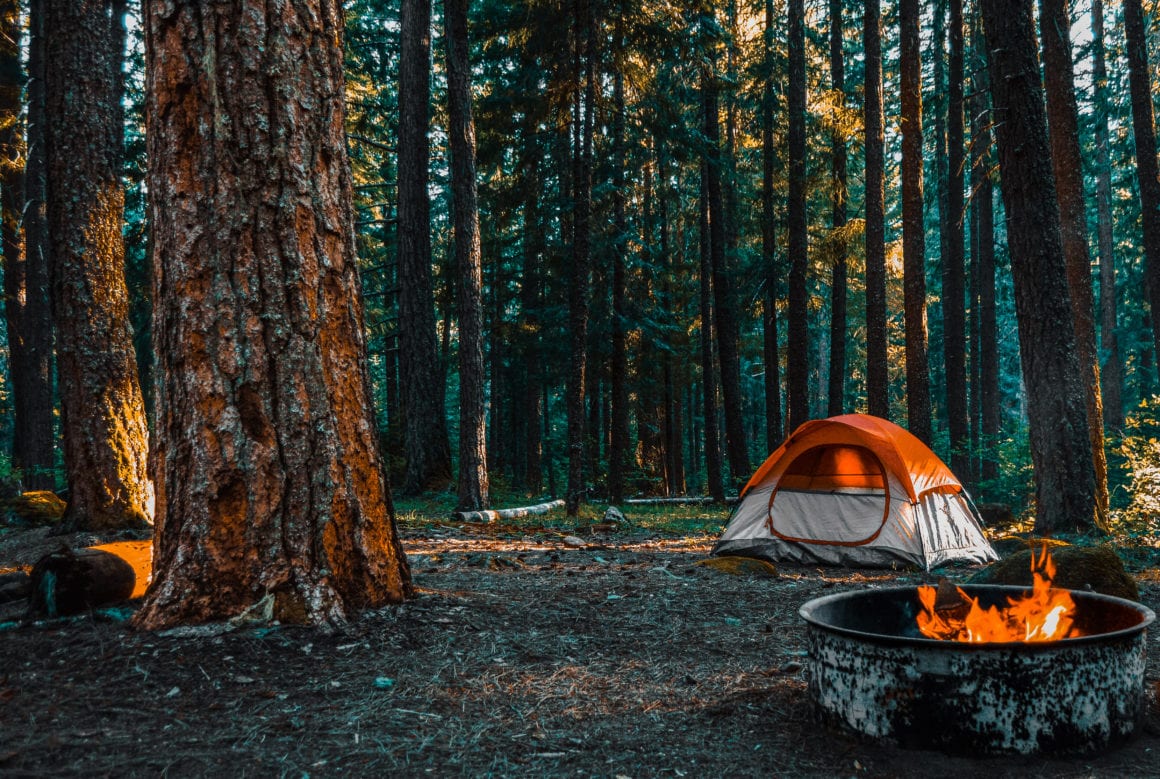
Big Meadows (Mile 51.2): Typically open from late March to mid-November, it’s first come, first served until May. Starting in May, it’s a combination of reserved and first-come, first-served sites. RV sites don’t have hookups. Don’t miss the evening ranger talk, especially the one about the night sky.
Lewis Mountain (Mile 57.5): Typically open from April to late October, this small campground offers first-come, first-served sites for RVs and tents.
Loft Mountain (Mile 79.5): Typically open from May to late October, it’s a combination of reserved and first-come, first-served sites. RV sites don’t have hookups. Catch a ranger program in the evening at the amphitheater with mountain views.
Dundo Group Campground (Mile 83.7): Typically open from May to late October, it’s a tent-only, reservations-only campground for groups.
If you want to camp outside the park, check out Jellystone Park Luray, Luray KOA, or Shenandoah River State Campground.
Backcountry camping
Backcountry campers have lots of options for dispersed camping around the park. All you need is a free backcountry permit issued by rangers at any visitor center; be sure to time your arrival during visitor centers’ open hours.
Eating in and around Shenandoah
Inside the park
At Meadows Lodge (Mile 51), you can settle in at Spottswood Dining Room, which serves several dishes named for Franklin D. Roosevelt, who delivered the park’s dedication speech in 1936. If the weather’s good, plan to grab a spot on the terrace. Whatever you order for your main course, make sure to save room for the signature blackberry ice cream pie.
The family-friendly New Market Taproom is also located in the main lodge. Order a drink and enjoy nightly, toe-tapping bluegrass music.
At Skyland (Mile 41.7), the Pollock Dining Room advertises farm-to-fork specialities and sumptuous views of the Shenandoah Valley. Here, too, you can snag a slice of that blackberry ice cream pie.
Pollock Dining Room serves buffet spreads on Easter, Mother’s Day, and Thanksgiving.

You’ll find both adult beverages and more live music on tap at the Mountain Taproom. Families are welcome.
Both the lodges plus the Elkwallow Wayside (Mile 24.1), Big Meadows Wayside (Mile 51), and Loft Mountain Wayside (Mile 79.5) offer grab-and-go snacks.
Outside the park
There are a variety of restaurants available in Charlottesville, Front Royal, Harrisonburg, Luray, and Waynesboro.
For a ranger favorite, try Rancho Viejo in Luray. Be sure to hit the salsa bar!
How many days should you plan to spend in Shenandoah National Park?
To get the full Shenandoah experience, plan to spend at least two nights so that you’ll have ample time to do multiple hikes, splash in a waterfall, visit Rapidan Camp, see Luray Caverns, and gaze up at the star-filled night sky. In other words, enjoy some peaceful detachment from the outside world.
But if you only have one day to visit Shenandoah, here’s a solid plan:
- Enter the park through the north entrance at Front Royal and head south on Skyline Drive. Stop occasionally at overlooks to take photos and breathe in the fresh mountain air.
- Stretch your legs on a hike to either Dark Hollow Falls (Mile 50.7) or Rose River Falls (Mile 49.4).
- Stop at the Byrd Visitor Center (Mile 51) to check out the exhibits. Walk over to Big Meadows Lodge for lunch on the terrace at Spottswood Dining Room. (Don’t forget to order the blackberry ice cream pie.) Then hop in a van for your pre-booked tour to President Hoover’s Rapidan Camp.
- If you still have the energy, do the hike and rock scramble at Bearfence (Mile 56.4).
- Finish driving Skyline Drive and then stop for a well-deserved dinner in Waynesboro.
Image header credit: Shutterstock
